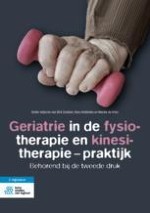Samenvatting
Schouderpijn in de oudere populatie is vaak te wijten aan een atraumatische degeneratieve rotatorcuff (RC)-scheur. Klachten op basis van een RC-scheur worden gekenmerkt door pijn in de anterolaterale regio van de schouder, bewegingsbeperking bij elevatie, pijnlijke weerstandsexorotatie en nachtelijke pijn. Het is bij de behandelkeuze ook belangrijk om de actualiteit van de klacht te achterhalen. De algemene tendens is om deze patiënten te behandelen met een oefenprogramma alvorens een chirurgische ingreep te overwegen. De oefentherapeutische aanpak bestaat uit oefeningen waarbij het accent ligt op het verbeteren (in range of motion (ROM) en in kracht) van de elevatie boven schouderhoogte met een minimale belasting (spieractiviteit) op de RC. De oefeningen die het meest aan deze voorwaarde voldoen zijn enerzijds geslotenketenoefeningen zonder belasting van het lichaamsgewicht op de schouders en anderzijds openketenoefeningen waarbij de externe weerstand een compressie geeft in het gewricht.
